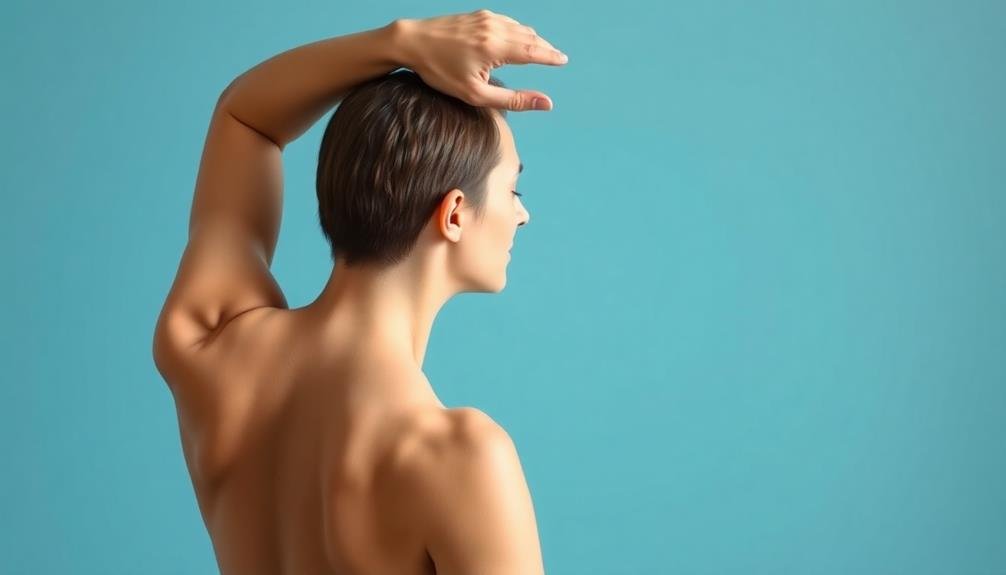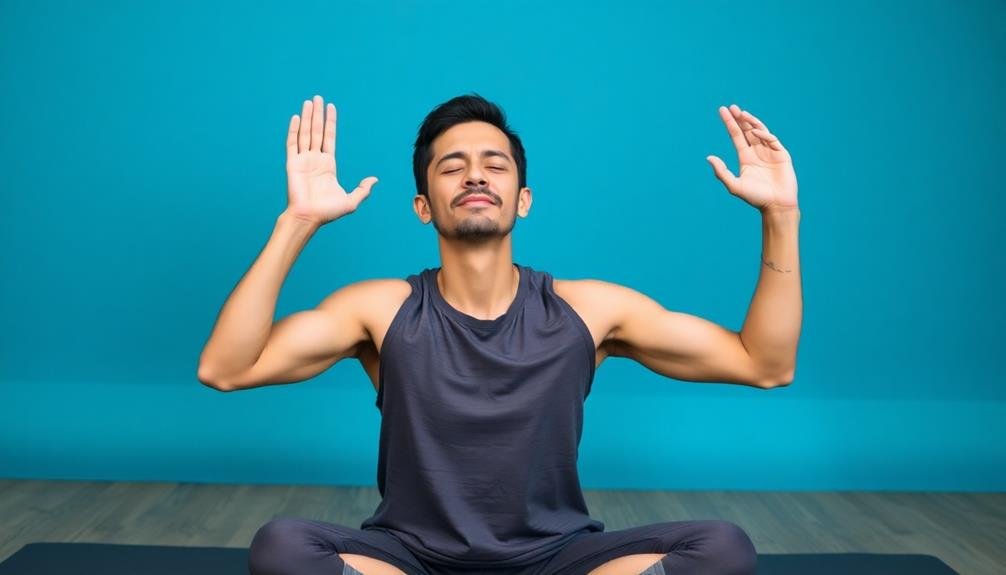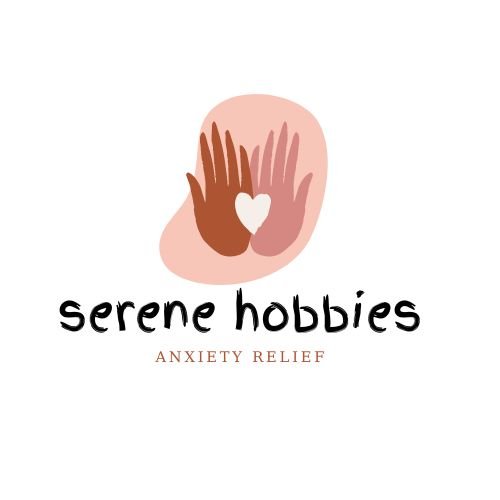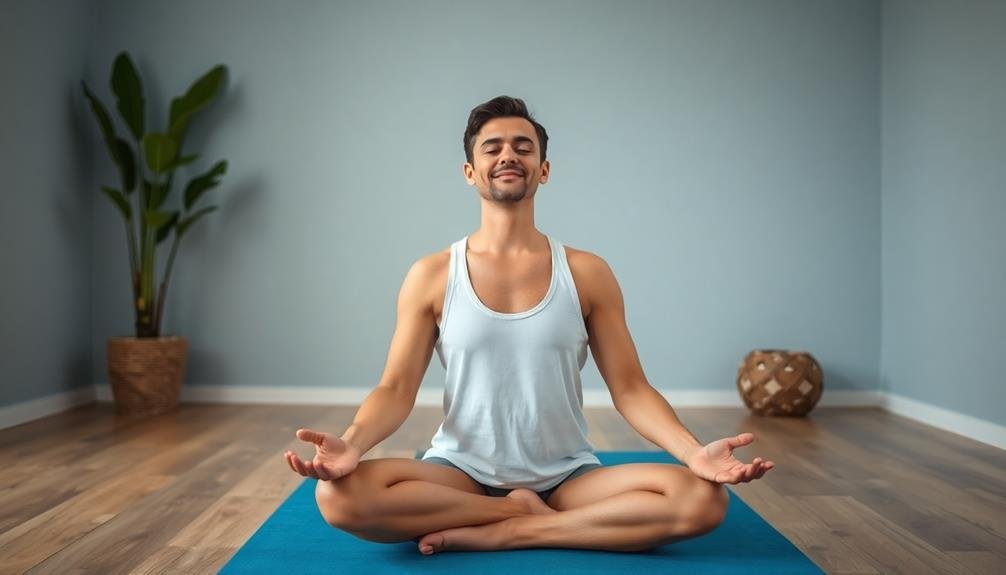To release anxiety-induced muscle tension, try these seven effective stretches: Neck Roll and Shoulder Shrugs for upper body relief, Child's Pose and Standing Forward Bend for back relaxation, Cat-Cow and Seated Spinal Twist for spine flexibility, and Legs-Up-the-Wall for lower body tension release. These exercises target key areas where stress accumulates, promoting relaxation and reducing physical discomfort. Incorporate Progressive Muscle Relaxation techniques to enhance awareness of tension patterns in your body. By practicing these stretches regularly, you'll improve your body's ability to manage stress and anxiety. Discover how each stretch can uniquely benefit your overall well-being and mental state.
Key Takeaways
- Neck Roll and Shoulder Shrugs target common areas of anxiety-induced tension in the upper body.
- Child's Pose provides gentle stretching for the spine, hips, and shoulders, promoting relaxation and easing lower back pain.
- Standing Forward Bend releases tension in vertebrae, improves posture, and calms the nervous system.
- Legs-Up-the-Wall pose reduces lower body tension, improves circulation, and encourages overall relaxation.
- Progressive Muscle Relaxation systematically tenses and relaxes muscle groups, enhancing body awareness and reducing anxiety-related physical discomfort.
Neck and Shoulder Release

Anxiety-induced muscle tension often takes a toll on your neck and shoulders, creating a painful tension-knot cycle. To break this cycle, incorporate these effective stretches into your daily routine.
Start with the neck roll: Gently lower your chin to your chest, then slowly roll your head to the right, back, left, and forward. Complete three full circles in each direction.
Next, try shoulder shrugs: Raise your shoulders towards your ears, hold for five seconds, then release. Repeat ten times.
For a deeper stretch, perform the cross-body shoulder stretch. Bring your right arm across your chest, using your left hand to gently pull the right arm closer to your body. Hold for 30 seconds, then switch sides.
Follow this with the upper trapezius stretch: Tilt your head to the right, bringing your ear towards your shoulder. Use your right hand to apply gentle pressure on the left side of your head. Hold for 30 seconds, then repeat on the other side.
Child's Pose for Back Relief

While neck and shoulder tension often dominates anxiety-related discomfort, your back can also bear the brunt of stress. Child's Pose, a gentle yoga position, offers a soothing stretch for your entire back, promoting relaxation and relief. To perform this stretch, kneel on the floor, then sit back on your heels. Slowly lean forward, extending your arms in front of you, and rest your forehead on the ground. Breathe deeply and hold this position for 30 seconds to a minute.
As you settle into Child's Pose, you'll feel a gentle stretch along your spine, hips, and shoulders. This position encourages your body to release tension and promotes a sense of calm. It's particularly effective for lower back pain and overall stress relief.
You can modify the pose by widening your knees for a deeper hip stretch or keeping them together for a more focused back stretch.
Child's Pose can evoke:
- A feeling of safety and comfort
- A sense of grounding and stability
- Relief from overwhelming thoughts
- A connection to your breath and body
- A moment of peace in a chaotic day
Incorporate Child's Pose into your daily routine to manage anxiety-induced muscle tension and promote overall well-being.
Standing Forward Bend

The Standing Forward Bend targets tension in your upper body, particularly the neck, shoulders, and back.
You'll experience relief as you allow your upper body to hang freely, releasing stress from these commonly tight areas.
To perform this stretch correctly, start with your feet hip-width apart, then hinge at your hips and let your upper body fold forward, keeping your knees slightly bent to protect your lower back.
Benefits for Upper Body
Standing Forward Bend offers a wealth of benefits for your upper body when dealing with anxiety-induced muscle tension. This simple yet effective stretch targets your shoulders, neck, and upper back—areas where stress often accumulates.
As you fold forward, gravity helps elongate your spine, releasing tension in your vertebrae and surrounding muscles. You'll feel an immediate release in your upper body as you allow your head and arms to hang freely. This position encourages blood flow to your brain, promoting relaxation and mental clarity.
The gentle inversion also helps calm your nervous system, reducing anxiety symptoms.
- Feel the weight of the world lift off your shoulders
- Experience a wave of relief washing over your tense muscles
- Embrace the soothing sensation of your spine lengthening
- Enjoy a moment of stillness as your mind quiets
- Rediscover the freedom of a relaxed upper body
Regular practice of Standing Forward Bend can improve your posture and increase flexibility in your upper body.
It's an excellent way to counteract the effects of prolonged sitting and hunching over devices. By incorporating this stretch into your daily routine, you'll cultivate a more resilient upper body that's better equipped to handle stress and anxiety.
Proper Form Technique
How can you guarantee you're performing the Standing Forward Bend correctly? Start by standing with your feet hip-width apart and your hands on your hips. Inhale deeply, then as you exhale, hinge forward at your hips. Keep your back straight as you fold, allowing your head to hang heavy. If you can't touch the floor, bend your knees slightly or rest your hands on your shins.
Maintain a neutral spine throughout the stretch, avoiding rounding your back. Your weight should be evenly distributed between your feet, with your heels firmly planted. As you hold the position, focus on relaxing your neck and shoulders. You'll feel a stretch in your hamstrings and lower back.
To deepen the stretch, gently sway side to side or nod your head yes and no. Hold for 30 seconds to one minute, breathing deeply.
When you're ready to come up, bend your knees slightly, place your hands on your thighs, and slowly roll up to standing, vertebra by vertebra. Take care not to rise too quickly to avoid dizziness.
Cat-Cow Spinal Stretch

One of the most effective stretches for releasing tension in your back and neck is the Cat-Cow spinal stretch. This dynamic movement combines two yoga poses to create a fluid motion that helps alleviate stress-induced muscle tightness along your spine.
To perform the Cat-Cow stretch, start on your hands and knees with your wrists aligned under your shoulders and knees under your hips. As you inhale, drop your belly towards the floor, lift your chin and chest, and gaze up towards the ceiling. This is the "Cow" pose.
As you exhale, round your spine towards the ceiling, tucking your chin to your chest and drawing your navel towards your spine. This is the "Cat" pose.
Continue alternating between these two positions, syncing your breath with each movement. Aim for 5-10 repetitions, focusing on the sensations in your body as you stretch.
- Feel the tension melting away with each breath
- Experience a wave of calm washing over your body
- Imagine your worries dissolving as you move
- Embrace the gentle rhythm of your breath and movement
- Sense a renewed connection between your mind and body
This stretch not only relieves physical tension but also promotes mindfulness, helping to calm your anxious thoughts and restore balance to your nervous system.
Seated Spinal Twist

Flexibility in your spine can greatly reduce anxiety-related tension throughout your body. The seated spinal twist is an excellent stretch to target this area, promoting relaxation and improved posture.
To perform this stretch, start by sitting on the floor with your legs extended in front of you. Bend your right knee and place your right foot on the outside of your left thigh. Place your left hand on the floor behind you for support, and bring your right hand to the outside of your right knee.
Inhale deeply, lengthening your spine. As you exhale, gently twist your torso to the right, using your right hand on your knee as leverage. Keep your spine straight and your shoulders relaxed. Hold this position for 30 seconds to a minute, breathing deeply.
With each exhale, try to deepen the twist slightly, but don't force it. You'll feel a stretch in your spine, obliques, and possibly your hips. After holding the stretch, slowly return to the center and repeat on the other side.
This stretch can help release tension in your back, improve spinal mobility, and promote a sense of calm throughout your body.
Legs-Up-the-Wall Relaxation

With your legs elevated, the Legs-Up-the-Wall pose offers a deeply restorative stretch that can greatly reduce anxiety-induced muscle tension. This simple yet effective pose promotes relaxation by gently stretching your hamstrings and lower back while encouraging blood flow to your upper body.
To perform this stretch, lie on your back with your buttocks close to a wall. Extend your legs up the wall, keeping them straight or slightly bent at the knees. Rest your arms by your sides, palms facing up. Close your eyes and focus on your breath, allowing tension to melt away.
As you settle into this pose, you may experience:
- A sense of weightlessness in your legs
- A calming effect on your nervous system
- Relief from lower back pain and discomfort
- Improved circulation throughout your body
- A gradual release of mental and physical stress
Maintain this position for 5-15 minutes, or as long as you feel comfortable. If you experience any discomfort, slowly lower your legs and rest.
Remember to breathe deeply and consciously throughout the stretch, allowing each exhale to release tension from your muscles. This pose is particularly beneficial before bedtime, helping to calm your mind and prepare your body for restful sleep.
Progressive Muscle Relaxation Technique

A powerful technique for reducing anxiety-induced muscle tension is Progressive Muscle Relaxation (PMR). This method involves systematically tensing and then relaxing different muscle groups in your body.
You'll start by finding a comfortable position, either sitting or lying down.
Begin with your feet and work your way up to your head. Tense each muscle group for about 5 seconds, then release and relax for 10-15 seconds. As you tense, focus on the sensation of tightness. When you relax, pay attention to how the muscles feel as they loosen.
Move through your body in this order: feet, calves, thighs, buttocks, abdomen, chest, hands, arms, shoulders, neck, and face. For each area, tense and relax twice before moving on.
As you practice PMR, you'll become more aware of what tension feels like in your body. This awareness will help you identify and release tension throughout your day.
With regular practice, you'll find it easier to relax your muscles on command, reducing overall anxiety and physical discomfort.
Frequently Asked Questions
How Long Should I Hold Each Stretch?
You should hold each stretch for 15-30 seconds. Don't rush; breathe deeply and relax into the stretch. If you're feeling particularly tense, you can extend the hold up to 60 seconds. Remember to stretch both sides equally.
Can I Do These Stretches if I Have a Pre-Existing Injury?
If you have a pre-existing injury, you should consult your doctor or physical therapist before trying new stretches. They'll advise you on safe exercises tailored to your condition. Don't risk aggravating your injury; always prioritize your health.
Are There Any Specific Breathing Techniques to Enhance These Stretches?
Yes, you can enhance these stretches with breathing techniques. Try deep diaphragmatic breathing, inhaling slowly through your nose for 4 counts, holding for 2, then exhaling through your mouth for 6. This'll help you relax and deepen the stretch.
How Often Should I Perform These Stretches for Optimal Results?
You'll get ideal results by stretching daily. Aim for 10-15 minutes per session, preferably in the morning or before bed. If you're particularly tense, you can stretch twice a day. Listen to your body and don't overdo it.
Can These Stretches Be Modified for People With Limited Mobility?
Yes, you can modify these stretches for limited mobility. You'll want to focus on gentle movements within your range of motion. Don't push too hard. Try seated or lying-down versions, and use props like cushions for support.
In Summary
You've now got a powerful toolkit to combat anxiety-induced muscle tension. Remember, these stretches aren't just physical exercises; they're your allies in stress relief. Don't hesitate to incorporate them into your daily routine. Whether you're at home, work, or on the go, you can always find a moment to stretch and breathe. Give your body and mind the care they deserve. You'll feel the difference, and your muscles will thank you.





Leave a Reply